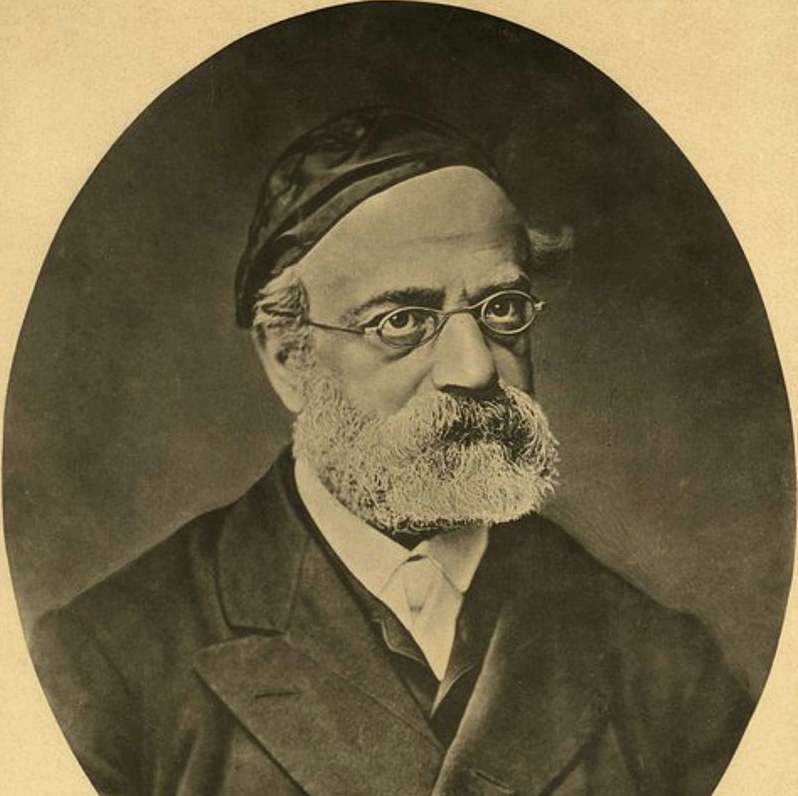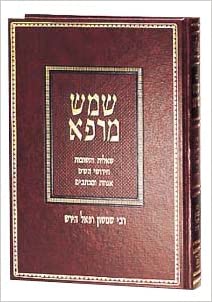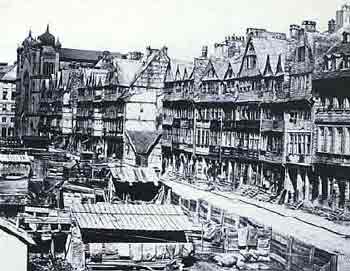HaRav Samson Raphael Hirsch zt"l
 HaRav Shamshon Rafael Hirsch was niftar on December 31, 1888, or 27 Teves, 5649. This year is thus 132nd anniversary of his passing. 27 years ago, we published this essay, marking the publication of Shemesh Marpeh a major study of HaRav Hirsch by HaRav Eliahu Meir Klugman. We are happy to republish it now on the Internet.
HaRav Shamshon Rafael Hirsch was niftar on December 31, 1888, or 27 Teves, 5649. This year is thus 132nd anniversary of his passing. 27 years ago, we published this essay, marking the publication of Shemesh Marpeh a major study of HaRav Hirsch by HaRav Eliahu Meir Klugman. We are happy to republish it now on the Internet.

Shemesh Marpeh
by HaRav Shimshon ben Raphael Hirsch
edited by Rav Eliyahu Meir Klugman
Published by HaRav Shimon Schwab in 1992
Distributed by ArtScroll
Part I
This sefer on the life and work of HaRav Shimshon ben Raphael Hirsch is not one work but rather four distinct literary works combined into one volume. It is truly a master work about a great Master. The space of an article is not enough to do justice to either, but we will present some of the highlights and some interesting sidelights.
After a brief overview in the sefer, there is a section which contains one hundred and one previously unpublished (save one) responsa of Rav Hirsch. This section is followed by some fifty pages of chidushim on sugyot of the gemara. These have for the most part been gleaned from Rav Hirsch's grand work: his Commentary on the Chumash. However, this edition is greatly enhanced by the inclusion of letters which Rav Hirsch received with comments from others on his explanations, and Rav Hirsch's responses to these.
The editor considers the third section, "The Letters," to be the highlight of this volume. This contains previously unpublished correspondence of Rav Hirsch. This portion has been subdivided into sections: a) the battle against reform; b) Eretz Yisroel; c) criticism both of individuals as well as organizations; d) communal affairs; e) efforts to aid Russian Jewry; and f) general correspondence with other Torah leaders.
The final section of the book is the only one not directly written by Rav Hirsch, but rather is a fifteen-chapter biography of Rav Hirsch written by the editor of the present volume, Rav Eliyahu Meir Klugman. As is explained in the forward, his purpose is not to present a complete biography, nor a biography in the usual sense at all. Rather, basing himself on the statement of chazal "ein ossin nefoshos letzaddikim, divreihem heim heim zichronom" — one doesn't erect monuments to tzadikim, they are remembered by their words — the author bases his biography on Rav Hirsch's writings themselves. Thus, based upon the above sections of this volume as well as other unpublished works of descendants of Rav Hirsch such as Rav Yosef Breuer, the editor is able to produce a fairly complete biography. Furthermore, the purpose of the biography is didactic rather than expository.
Therefore, after the first four chapters which are titled a) "Youth;" b) "Oldenberg and Emden;" c) "Nicholsburg;" d) "Frankfurt;" (the latter three being the localities in which Rav Hirsch held positions) the work continues with chapters which are devoted to particular aspects of Rav Hirsch's activities and philosophies. We find chapters titled "Torah Im Derech Eretz," "Education," "Divine Torah," etc. The editor explains that his purpose in writing this section is to enable Rav Hirsch's followers to learn not only from Rav Hirsch's words but also from his actions.
The Lessons of Rav Hirsch and His Period For Today
The adage, "He who does not study history is doomed to repeat it," is a tragic description of the recent history of Klal Yisroel. The 150 year period starting with the French Revolution and concluding with World War II saw, in country after country, the same pattern: emancipation followed by Jewish assimilation. Due primarily to Rav Hirsch, Germany was almost unique in that religious Judaism fought back and was able to withstand to a certain extent the inroads made by Reform Judaism and to offer the general public a viable alternative to Reform. While we find other bastions such as the Yeshivos and various well-organized communities (many of them Chassidic) who were able to withstand the onslaught of reform, none had the ability to actually fight back against reform. Perhaps if American Jewry had applied Rav Hirsch's philosophy in the later 1800's the specter of pre-World War II American Jewry would have been radically altered. Instead, the pattern was similar to that of German Jewry in the early 1800's — Orthodox Jewry led by old, Torah-true Rabbonim who attacked the "modern approach." However, since they had no alternative approach to offer, they were unable to influence the masses.
The Jewish street of Frankfurt around the time of HaRav Hirsch

As is mentioned in the Foreword, Rav Hirsch's work has not been relegated to the history department, but, on the contrary, it serves as the source for many of our modern-day institutions. Rav Hirsch's era was one of great upheaval in Western society generally. However, in many respects, the culture and society of today is merely an adaptation of its nineteenth century counterpart, rather than a radical transformation. Thus, Rav Hirsch's system in which a strictly Orthodox Jew can live within modern society, is as timely as ever and the study of Rav Hirsch's work helps one understand the foundation of modern-day Orthodox Jewish society.
The Responsa of Rav Hirsch
The Responsa of Rav Hirsch consist of two types: a) those which are questions based on the influence of Reform, and b) those which are general halachic queries. In all situations Rav Hirsch writes with great humility as is befitting one so steeped in yiras shomayim as it says "eikev anovo yiras Hashem." He frequently uses expressions such as "it seems to me based on my limited understanding that..." In no sense did this prevent him from taking a clear stand on an issue. Rather it is a sign of his anovo.
In one of the first responsa, one sees Rav Hirsch offering Talmudic proof that one may not change minhagim. In this case the issue was davening in German. Even on a matter such as allowing a number of people to recite Kaddish together, Rav Hirsch prefaces his remarks by saying that in no case may the minhag be changed to allow a number of people to recite at the same time. Thus, even though, the Sephardic minhag is for any number of people to say Kaddish together, for an Ashkenazic community to adopt the Sephardic minhag would run contrary to the halacha.
We do find one situation in which he permitted—bish'as hadchak ve'igun godol—a couple to marry during the three weeks, since it's only a minhag to refrain from doing so. He does, however, stipulate that no dancing and music take place, that no more than ten people attend and that notice be served that only due to extraordinary circumstances is the marriage taking place.
The fact that one of his conditions was that the marriage take place without any music is interesting, since the Maharil (Hilchos Eruvei Chatzeiros No. 7) ruled that in a case where, due to the death of the ruler of a town the goyim didn't allow music at marriages, people shouldn't get married without music and, if possible, they should rather go to another town where they can have music. Based on this (according to Magen Avrohom) the Ramo rules (338:2) that one may even tell a goy not only to play but even to fix a musical instrument on Shabbos in order to play at a wedding!
It is also of interest in view of the fact that the Shevus Yaakov says (2:35) that the reason not to marry in the three weeks is due to lo mesamna milso, it doesn't bode well for the nuptial couple, and chamira sakanta me'issura. Thus, according to him, eve if there are many reasons to be lenient it's not a good idea to marry in a time in which so many tragic events have befallen Klal Yisroel.
Marriage in Shul
Another interesting responsum concerning marriage involves the question of having the marital ceremony take place in a shul (Responsa 98 and 99). Rav Hirsch permits this practice based on historic evidence that it had been common in previous generations. This is very interesting because we find that the Chasam Sofer (Even Haezer 1:98) and his son, the Kesav Sofer, were very strongly opposed to this practice. Although the Chasam Sofer (ibid.) bases his objection upon the Ramo (61:1) that it's a siman brocho for one to be married directly under the sky, and, hence, one who marries in shul forfeits that blessing, as is explained in Igros Moshe (1:93), the true reason why they were so very opposed was that the practice of having the marriage ceremony inside the shul had been adopted by Reform in order to follow the gentile custom.
Rav Hirsch explains an important principle: one should oppose Reform practices whenever the practice contravenes the halacha or minhag. However, where Reform merely stressed a minhag which is halachically proper, then it is preferable that one not oppose them.
It's probable that the dispute between Rav Hirsch and the Chasam Sofer ultimately stems from the question of what the original minhag of Orthodox Jewry was. The Chasam Sofer claims that the minhag was not to marry in shul, even explaining that in places such as Frankfurt where a marriage ceremony was performed in shul it was only the second stage of the marriage ceremony (a kind of chuppah that we do not do altogether today), the first part having taken place outside. Rav Hirsch, on the other hand, claims that the Ramo's statement that one should marry outside was not adopted by Klal Yisroel and the minhag was to perform marriages in shul. He states that such is his minhag as well.
Thus in theory both gedolim agree that if it were not the minhag then it would be prohibited to start such a practice, and the only question is — what is the original minhag Ashkenaz? This also explains the fact that in responsum 47 the Kesav Sofer says that one who marries in shul is over on Uvechukosayhem lo seilechu whereas according to Rav Hirsch it's a proper Jewish minhag. Rav Hirsch seems to have been unaware of the fact that Chasam Sofer and Kesav Sofer opposed the practice, since he doesn't mention their opinion. This is quite understandable since their responsa were not yet published at the time he wrote.
Another interesting observation that can be made from this responsum is another principle of Rav Hirsch: communities should turn to the gedolim of their region wherever possible and not to outside gedolim. Thus, in responsum 80 he tells the rav to turn to his area's gedolim and really doesn't voice an opinion. Instead he just describes his personal practice. He says that one should always consult the local authorities for the purpose of sholom and emes. This advice seems to have been needed since, in fact, this very kehilla was the recipient of responsum 106 of Kesav Sofer which ruled against Rav Hirsch's practice mentioned above.
He practiced this principle of non-interference once again when the question of education in Eretz Yisroel arose. There was a plan to open an orphan home in Yerushalaim in which, besides limudei kodesh, the students would be given a few hours of education in limudei chol. Rav Hirsch, in a letter to Rav Hildesheimer (letter 13 in this volume) relates that, "Just like only in Berlin can one decide what's good for Berlin, and only in Frankfurt does one know what's worthwhile for Frankfurt, so too only those who live in Eretz Yisroel and their Rabbonim can know what's best for them."
A precedent for Rav Hirsch is found in the Responsa of the Mahari Bruna number 33. He writes, "I accepted upon myself ... not to write anything about disputes outside my country ... and if you claim that justice won't be performed ... the generation is not orphaned and there are judges in the land."
End of Part I




